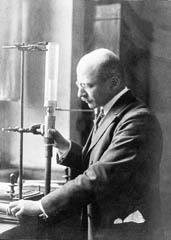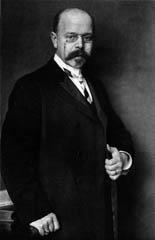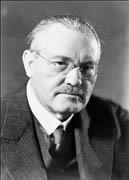Although Fritz Haber's name is now attached to the process for the synthesis of ammonia from its constituent elements by using high pressure, who was responsible for this reaction?
- Nernst's third law of thermodynamics conflicted with Haber's 1905 data on the NH3 equilibrium, so he investigated the reaction himself
- Haber, provoked by Nernst's results, fine- tuned his earlier experiments to produce ammonia in high yield at 600°C, 200 atm
Ammonia was first synthesised in appreciable yield from its constituent elements by using high pressure and moderate temperatures 100 years ago. The person responsible for this reaction was German chemist Walther Nernst, not Fritz Haber whose name is now attached to the process. This is the story.
Ammonia was first produced from its elements in 1807 by Humphry Davy. He electrolysed distilled water in the presence of air and detected small amounts of ammonia. The water was contained in gold cups connected by a strip of water-moistened, purified asbestos rope. The same experiment, done in a vacuum, produced only oxygen and hydrogen. Over the next century various workers challenged this result, curiously not by replicating Davy's exact conditions (using gold electrodes and a low current density) but using, typically, platinum electrodes and a high current density. In 1922 Friedrich Fichter and Richard Suter synthesised ammonia at a rate of 0.3 mg/minute by using a current of 100 A and a pressure of 200 atm. Clearly methods based on electrolysis were not going to be economical, despite some optimistic patents arising from this research.
19th and early 20th century syntheses of ammonia
In the 1850s, electricity was still being used to try and combine the gases. A 'brush discharge' (high voltages maintained across electrodes, just below sparking potential)1 gave yields of up to 3 per cent, and higher if the pressure was increased. Moreover the optimum temperature for the reaction was between 450 and 550°C. Above 650°C no ammonia was detected because of the instability of the gas at this temperature. No industrial processes developed from these reports, presumably because the process used a lot of energy.
In the 1870s, when thermodynamics was in its infancy and the proposition that exothermicity was the sole criterion of a spontaneous reaction was generally accepted, calculations independently by Julius Thomsen and Marcellin Berthelot showed that the theoretical heat of formation of NH3 was ca 50 kJ mol-1. This result, however, contradicted what was already known about ammonia, ie on heating the gas reverted to its elements, it was thermally unstable.
As late as 1904, only three years before the process to which Haber's name is attached, Edgar Perman, assistant professor at University College Cardiff, wrote: 'We have assumed that the decomposition of ammonia is an irreversible process', and cited evidence from a paper written 20 years previously by William Ramsay and Sidney Young: ' [they] showed that passing a mixture of dry nitrogen and dry hydrogen through a heated glass tube containing iron filings . no appreciable quantity of ammonia was formed'. However, further investigation into both Perman's paper and that of Ramsay provide additional insight into the reaction.
Perman reported that his thermal decomposition of ammonia was never complete: 'a trace of ammonia was always found undecomposed in the (heated reaction) globe at the end of the experiment, but this may have come from the cold stem (of the apparatus)'. Indeed it might, but hindsight would suggest that it might have resulted from an equilibrium process between nitrogen, hydrogen and ammonia.
Ramsay and Young had been motivated into action by two papers, one by Henri Sainte-Claire Deville (1865) who observed that even on prolonged sparking, some ammonia always remained undecomposed, and another by William Donkin who reported that ammonia was formed in small quantities by silent discharge through nitrogen and hydrogen (1873).
Ramsay chose to work, mainly, on the 'Deville' reaction - the decomposition of NH3 - and to identify the conditions which facilitated the process. At 500°C, 1.6 per cent ammonia was decomposed, 520°C, 2.5 per cent; 600°C, 18.3 per cent; 820°C, 69.5 per cent. They concluded: 'It may fairly be assumed that the temperature at which ammonia begins to decompose . lies a little below 500°C'.2 The progression of their experimental results clearly shows that, assuming a reversible reaction, the synthesis of ammonia would be a relatively low temperature process.
What of the effects of pressure? Ramsay's work here was bedevilled by exploding (glass) apparatus; the only time this did not happen was when he used a sealed tube of ammonia held at 780°C for six hours. No appreciable decomposition was observed. Reversing his reaction (ie, synthesising ammonia) and applying pressure at an appropriate temperature, might conceivably have produced ammonia. Actually, Ramsay and Young synthesised ammonia by using a combination of two of the three 'Haber' conditions. They passed the dry N2 and H2 down a red-hot tube containing iron filings and produced a trace of ammonia. However, they suggested that water vapour (despite working with 'dry' gases) might have reacted with the iron to form 'nascent' hydrogen that had sufficiently enhanced reactivity to attack the nitrogen.
During the first few years of the 20th century several chemists tried to synthesise ammonia, possibly egged on by a growing need for more nitrogenous fertilisers to match the anticipated population growth. In 1902, Wilhelm Ostwald patented an industrial version of an 1838 process for converting ammonia into nitric acid and nitrates,3 the latter being swifter acting plant nutrients than ammonium salts.
The idea of chemical equilibrium and the factors affecting it were widely accepted after Henri-Louis Le Chatelier's publication of his eponymous Principle in 1884.4 Indeed Le Chatelier himself had almost achieved the goal of ammonia synthesis in 1901, only to abandon his research when the presence of air in his feedstock caused a devastating explosion in his laboratory. He later realised that he had been using classic 'Haber' conditions (600°C, 200 atm and an iron catalyst) and near the end of his life wrote: 'I let the discovery of the ammonia synthesis slip through my hands. It was the greatest blunder of my scientific career'.4 Other 19th and early 20th century attempts to synthesise ammonia met with failure.5,6
Enter Fritz Haber

Fritz Haber was born in 1868 and was one of the most gifted chemists of his generation. In the period 1900-05 he published 50 papers, mainly in physical chemistry. In 1904 he received a request from the Österreichische Chemische Werke of Vienna to investigate the synthesis of ammonia from its elements. This would be a daunting project.
Although the reaction was energetically favourable, Haber reasoned: '... that earlier attempts had not succeeded, even fleetingly, in achieving with absolute certainty, a spontaneous union of nitrogen and hydrogen to form ammonia ... (and) this gave rise to the prejudice that such a production of ammonia was impossible'.7
Nevertheless, Haber was intrigued by Ramsay's 1884 paper which seemed to imply that an equilibrium of N2, H2 and NH3 might well exist and so he decided to explore this reaction. He worked with his young assistant, Gabriel van Oort, and acquired data around 1000°C: at 927°C, the percentage of NH3 in the equilibrium mixture was 0.024 per cent, and at 1020°C, 0.012 per cent.8 They then used the van't Hoff equation (published in 1884) to predict the amount of ammonia in the equilibrium mixture at lower temperatures (see Table 1).
| Table 1: Van't Hoff equation predicts the amount of NH3 in the equilibrium mixture at lower temperatures (at 1 atm) | |
|---|---|
| Temperature/°C | Percentage NH3 |
| 27 | 98.5 |
| 327 | 8.7 |
| 637 | 0.21 |
| 927 | 0.024 |
| 1012 | 0.012 |
| Original table from BASF Corporate Archives Ludwigshafen/Rhine | |
The van't Hoff equation showed that relatively low temperatures favoured the process. If the unreacted gases could be recycled, and if an appropriate catalyst could be developed, then the process might have potential. But Haber was not convinced:
'From dull red heat upwards, no catalyst can produce more than a trace of ammonia under ordinary pressure. Even at greatly increased pressures, the position of equilibrium must remain unfavourable. To attain practical success with a catalyst at ordinary pressure, its temperature must be no higher than 300°C'.7
Haber viewed the problem as insoluble, and temporarily his work on the synthesis of ammonia stopped.
Influenced by Nernst

At about the same time that Haber was investigating the synthesis of ammonia Walther Nernst was developing his 'heat theorem', later to be known as the third law of thermodynamics. Nernst (born 1864) was slightly older than Haber and by the turn of the century enjoyed a good reputation as a physical chemist. He was looking for examples to illustrate his theory (finally published in 1906) and considered that Haber and van Oort's 1905 results would be a good test. But his law conflicted with the experimentally derived data - the percentages quoted were too high - and so he decided to investigate the equilibrium reaction himself.
Nernst chose to work at 30-75 atm. This, he reasoned, would make the ammonia concentrations more accurately measurable. He reported his successful synthesis in 1907. Thus, as Haber's biographer J. E. Coates says: 'Nernst was the first to synthesise ammonia under pressure'.9 He might have added 'and at elevated temperatures, thus anticipating Haber's later experiments and the reaction that bears his name'.
In 1906 Nernst informed Haber of his experimental results and this provoked Haber (now working with Channel Islander Robert Le Rossignol) to take up the challenge again. In 1907 Nernst published the data from his pressure reactions and, a few months later, Haber published his work on the extent of the conversions, again working at 1 atm pressure. His results were about 50 per cent higher than Nernst's (when converted to the same pressure). Nernst responded robustly, and in public, perceiving Haber to be in error. Coates takes up the story:
'Haber felt this episode deeply as a personal slight and an injury to his reputation. Without delay, therefore, he and Le Rossignol began a new and decisive determination of the equilibrium, this time under a pressure of 30 atm. (This work) published in 1908 (also) fully confirmed their earlier work at 1 atm'.

Moreover, Haber and Le Rossignol's results suggested that some 8 per cent of ammonia might be produced at about 600°C and 200 atm pressure. Such conditions were just about achievable at that time with available compressors, but only on the lab bench. Effective catalysts (uranium, osmium and specially treated iron) were developed with this small-scale apparatus and the results announced in 1908. Soon a pilot scale was producing a few hundred millilitres of liquid ammonia per hour, with very little expenditure of energy.
In July 1909 BASF representative Dr Carl Bosch saw the plant in action and noted both its potential and the fact that the engineering difficulties inherent in scaling it up to produce tonnage amounts of product would not be insurmountable. He took the process to his Ludwigshafen laboratories for development and the rest is history.
The construction of a plant at Oppau, near Ludwigshafen was started in 1911 and became operational in September 1913, soon producing 7000 tonnes NH3 per year. Germany's increasing needs for ammonia and the nitrates derived from it led to the building of a large plant at Leuna, near Merseburg, and located in the lignite coalfields of central Germany. Its initial capacity was 33,000 tonnes NH3 per year and, by the end of World War I this had expanded to an annual production of 146,000 tonnes of ammonia.10
The reaction that changed the world
The Haber-Bosch process was important because it addressed two quite different concerns that arose at the beginning of the 20th century. The importance of fixed nitrogen (nitrogen compounds) as a fertiliser, especially for cereals, had been grasped. Initially the demand was met from various sources in Nature, ranging from the coprolite (fossilised dung) beds of Cambridgeshire to the guano (bird dung) beds found on islands off Peru. By the end of the 19th century, these had been largely superseded by native sodium nitrate (Chile saltpetre) mined in the arid Atacama desert.
At the same time, the military were developing high explosive shells, filled with picric acid (trinitrophenol) in Britain and trinitrotoluene (TNT) in Germany. This increased demand for nitric acid could be met by oxidising ammonia to nitric acid using oxygen gas, using the Ostwald process, but the supplies of ammonia from gasworks and coke production was limited.
When World War I broke out, the Allies assumed that Germany and Austria-Hungary would be cut off from the South American supplies of fixed nitrogen and thus be unable to make high explosives and/or feed their populations. Another nitrogen-fixing process, the Frank-Caro cyanamide process,* kept the Central Powers going in the early years of the war. The output from Oppau alone was simply not enough to meet the demand.
In April 1917, however, BASF completed the construction of the huge Haber-Bosch plant at Leuna, which was able to supply enough ammonia to meet the demands for explosives but not to cover Germany's need for fertilisers. Near starvation was one of the causes of Germany's defeat in 1918.
Technology interfaces with politics
If the political ramifications of the Haber-Bosch process are a matter of debate, there is no doubt about its technological and industrial impact. The construction of high-pressure equipment led to the development of a process to make oil from coal. Such were the financial costs of this hydrogenation process (on top of the already heavy costs of the Haber-Bosch process) that it accelerated the amalgamation of the major German chemical companies to form IG Farben in 1925. This brought about the formation a year later of Imperial Chemical Industries (ICI) with a mission to develop its own high-pressure chemistry. As high-pressure chemistry threatened to bankrupt both IG Farben and ICI, it led to the setting up of international cartels to control sales and an increasing reliance on rearmament to keep the industry going. Both the Haber-Bosch process and coal hydrogenation were crucial to Hitler's ability to wage war against France and Britain in September 1939 and attack the Soviet Union in June 1941.
After World War II, international concern turned from the ability to wage war to the need to prevent starvation, initially in war-ravaged Europe and then in Africa and Asia where the population was growing rapidly. The green revolution in plant genetics played its part, but it was largely the Haber-Bosch process, now using natural gas and much more efficient, that saved the world from starvation.
Now we worry more about the dangers of nitrate pollution from the run-off of rainwater from farmland and obesity rather than starvation. Yet, as world population continues to grow, the future of the Haber-Bosch process seems assured.
Alan Dronsfield is emeritus professor of the history of science in the faculty of education, health and sciences at the University of Derby, Derby DE22 1GB. Dr Peter Morris is manager of research and residencies at the Science Museum, South Kensington, London SW7 2DD
Further Reading
Vaclav Smil's text6 is a masterful account of the Haber process and is well recommended. The best biography of Haber is probably the one by Dietrich Stoltzenberg.11 A good short overview of the development of the Haber-Bosch process has been written by Tony Travis12 and a comprehensive survey of the international nitrogen industry in the 1920s can be found in the monograph by Bruno Waeser.13
Claude Berthollet decomposes ammonia, 1785
The discovery of gaseous ammonia is generally attributed to Joseph Priestley around 1773-4, though some would argue that this species was first identified by Johann Jacob Wepfer, a physician, who obtained it by the distillation of putrefied wine yeast in 1679. Priestley decomposed his product by passing sparks through it, and noticed an increase in volume which he linked to the formation of a flammable gas, but took his work no further.

The discovery that it was a compound of nitrogen and hydrogen is attributed to Claude Louis Berthollet who, by exploding it with oxygen, decided in 1785 that it comprised 2.9 volumes of 'inflammable air' (hydrogen) to 1.1 volumes of azote (nitrogen).
Naturally, its constituent gases had been discovered earlier: hydrogen is usually attributed to Henry Cavendish (1766) and nitrogen to Daniel Rutherford in 1772. Having established that ammonia, like water, was a relatively simple substance it would have been a reasonable goal to attempt its formation from its elements. Hydrogen exploded when ignited with oxygen to form water (Cavendish, 1784) but presumably more forcing conditions would be necessary to combine hydrogen with the relatively unreactive nitrogen gas.
References
- J. W. Mellor, A comprehensive treatise on inorganic and theoretical chemistry, Vol 8. London: Longmans, Green, 1931.
- W. Ramsay and S. Young, J. Chem. Soc., 1884,45, 88.
- Ostwald's conversion of ammonia into nitric acid and nitrates see website
- For biographical details of Le Chatelier and for applications to the ammonia synthesis log onto websites
- E. K. Rideal and H. S. Taylor, Catalysis in theory and practice. London: Macmillan, 1926.
- V. Smil, Enriching the earth: Fritz Haber, Carl Bosch and the transformation of world food production. Cambridge Massachusetts: MIT, 2000.
- F. Haber in Nobel lectures in chemistry 1901-1921. Amsterdam: Elsevier, 1966.
- K. Tamaru in Catalytic ammonia synthesis: fundamentals and practice, J. R. Jennings (ed). London: Plenum, 1991.
- J. E. Coates in Memorial lectures delivered before the Chemical Society 1933-42. London: The Chemical Society, 1951.
- J. F. Thorpe and M. A. Whiteley, Thorpe's dictionary of applied chemistry, Vol 1, 4th edn. London: Longmans, Green, 1937.
- D. Stoltzenberg, Fritz Haber: chemist, laureate, German Jew. Philadelphia: Chemical Heritage, 2004.
- A. S. Travis, in Determinants in the evolution of the European chemical industry, 1909-1939, A. S. Travis (ed). Dordrecht: Kluwer, 1998.
- B. Waeser, The atmospheric nitrogen industry with special consideration of the production of ammonia and nitric acid, two volumes. Philadelphia: P. Blakiston's, 1926.









2 readers' comments